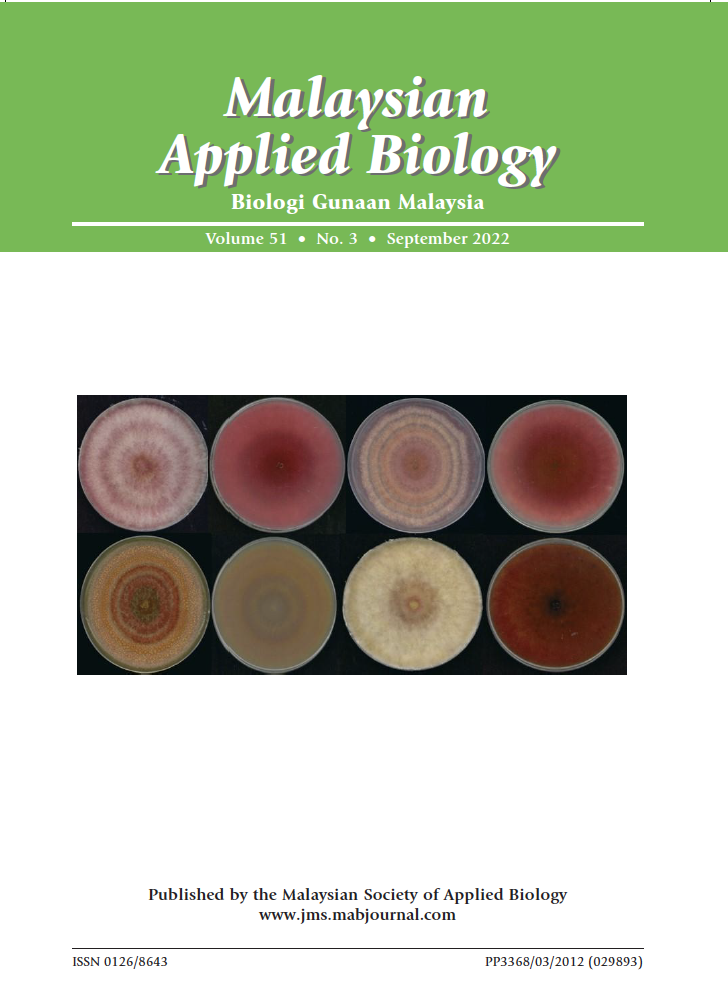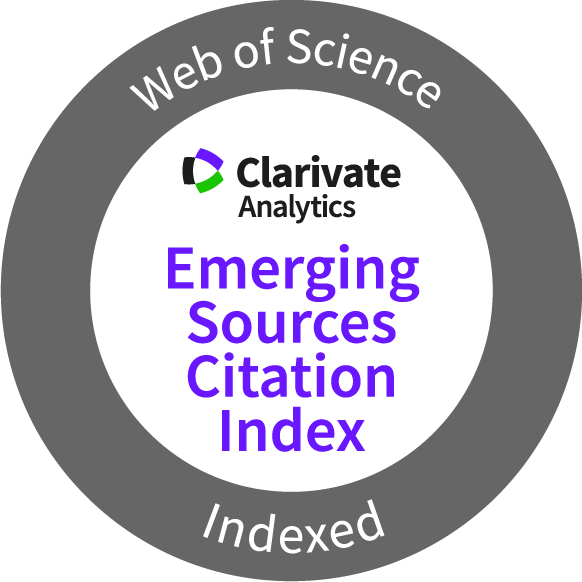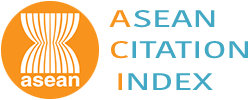FATTY ACIDS AND TERPENOIDS FROM Canarium odontophyllum MIQ. LEAF AND THEIR ANTIOXIDANT AND CYTOTOXIC EFFECTS ON UVB-INDUCED IMMORTALIZED HUMAN KERATINOCYTES CELLS (HACAT)
Keywords:
Terpenoids, fatty acids, Canarium odontohyllum, human keratinocytes, antioxidantAbstract
The study evaluated the antioxidant capacity of hexane extract of Canarium odontophyllum Miq. leaf; its fatty acids and terpenoids content; and cytotoxic effects on UVB-induced human keratinocytes (HaCaT). FRAP assay was used to determine antioxidant capacity. GC-MS analysis to identify the fatty acids and terpenoids’ in the hexane extract of Canarium odontophyllum Miq. leaf. MTT (3-(4,5-dimethylthiazol-2-yl)-2,5-diphenyltetrazolium bromide) assay was carried out to measure the cytotoxic effects of the extract on UVB-induced human keratinocytes. Serial doses of up to 1000 µg/mL extract were administered before UVB irradiation of the cells. FRAP assay showed the extract was found to exhibit antioxidant activity but no significant difference in ascorbic acid equivalent antioxidant capacity (AEAC) between dose 500 µg/mL (5.00 ± 0.35 AEAC) and 1000 µg/mL (5.70 ± 0.29 AEAC) extract. GC-MS analysis showed the extract contained 88.93% of fatty acids and terpenoids, especially n-hexadecanoic acid, spathulenol, and phytol. MTT assay showed no IC50 value for the tested extract dose on UVB-induced HaCaT. Thus, the results suggest the potential application of hexane extract of C. odontophyllum Miq. leaf in terpenoids’ studies. In-depth research and isolation of compounds of interest should be done to develop it as a viable medical phytotherapeutic agent.
Downloads
Metrics
References
Abdul Aziz, M.W.H, Masre, S.F., Basri, D.F. & Ghazali, A.R. 2022. Canarium odontophyllum Miq. (Dabai) leaf phytoextracts and their medicinal properties. Pertanika Journal of Science & Technology, 30(3): 2115-2125. DOI: https://doi.org/10.47836/pjst.30.3.20
Aparna, V., Dileep, K.V., Mandal, P.K., Karthe, P., Sadasivan, C. & Haridas, M. 2012. Anti-inflammatory property of n-hexadecanoic acid: Structural evidence and kinetic assessment. Chemical Biology & Drug Design, 80: 434-439. DOI: https://doi.org/10.1111/j.1747-0285.2012.01418.x
Basri, D.F. & Nor, N.H.M. 2014. Phytoconstituent screening and antibacterial activity of the leaf extracts from Canarium odontophyllum Miq. American Journal of Plant Sciences, 5(Sept.): 2878-2888. DOI: https://doi.org/10.4236/ajps.2014.519303
Basri, D.F., Heng, K.Y. & Ghazali, A.R. 2014. Screening of antioxidant phytoextracts of Canarium odontophyllum Miq. leaves in vitro. IOSR Journal of Pharmacy, 4(12): 1-6.
Basri, D.F., Ishak, S.A., Azmi, F.F., Zahari, A.S. & Latif, E.S. 2017. Antimalarial activity of Canarium odontophyllum leaf extracts against erythrocytes infected with Plasmodium berghei NK65. Medical Journal of Malaysia, 72: 45.
Basri, D.F., Shabry, A.S.M. & Meng, C.K. 2015. Leaves extract from Canarium odontophyllum Miq. (Dabai) exhibits cytotoxic activity against human colorectal cancer cell HCT 116. Natural Products Chemistry & Research, 3: 1-4. DOI: https://doi.org/10.4172/2329-6836.1000166
Benzie, I.F.F. & Strain, J.J. 1996. The ferric reducing ability of plasma (FRAP) as a measure of ‘antioxidant power’: the frap assay. Analytical Biochemistry, 239: 70–76. DOI: https://doi.org/10.1006/abio.1996.0292
Budin, S.B., Kumar, S., Warif, N.M.A., Saari, S.M. & Basri, D.F. 2018. Protective effect of aqueous extracts from Canarium odontophyllum Miq. leaf on liver in streptozotocin induced diabetic rats. Life Sciences, Medicine and Biomedicine, 2(1). DOI: https://doi.org/10.28916/lsmb.2.1.2018.5
do Nascimento, K.F., Moreira, F., Alencar Santos, J., Kassuya, C., Croda, J., Cardoso, C., Vieira, M., Góis Ruiz, A., Ann Foglio, M., de Carvalho, J.E. & Formagio, A. 2018. Antioxidant, anti-inflammatory, antiproliferative and antimycobacterial activities of the essential oil of Psidium guineense Sw. and spathulenol. Journal of Ethnopharmacology, 210: 351–358. DOI: https://doi.org/10.1016/j.jep.2017.08.030
D’Orazio, J.A., Jarrett, S.G., Amaro-Ortiz, A. & Scott, T.L. 2013. UV radiation and the skin. International Journal of Molecular Sciences, 14(6): 12222. DOI: https://doi.org/10.3390/ijms140612222
Ghazali, A.R., Khairuddin, F.M., Nagapan, T.S. & Basri, D.F. 2017. The mutagenicity and antimutagenicity of Canarium odontophyllum (dabai) acetone leaves extracts. Journal of Agricultural Science, 9: 62-72. DOI: https://doi.org/10.5539/jas.v9n13p62
Harada, H., Yamashita, U., Kurihara, H., Fukushi, E., Kawabata, J. & Kamei, Y. 2002. Antitumor activity of palmitic acid found as a selective cytotoxic substance in a marine red alga. Anticancer Research, 22(5): 2587–2590.
Islam, M.T., Ali, E.S., Uddin, S.J., Shaw, S., Islam, M.A., Ahmed, M.I., Chandra Shill, M., Karmakar, U.K., Yarla, N.S., Khan, I.N., Billah, M.M., Pieczynska, M.D., Zengin, G., Malainer, C., Nicoletti, F., Gulei, D., Berindan-Neagoe, I., Apostolov, A., Banach, M., Yeung, A.W.K, El-Demerdash, A., Xiao, J., Dey, P., Yele, S., Jóźwik, A., Strzałkowska, N., Marchewka, J., Rengasamy, K.R.R., Horbańczuk, J., Kamal, M.A., Mubarak, M.S., Mishra, S.K., Shilpi, J.A. & Atanasov, A.G.. 2018. Phytol: A review of biomedical activities. Food and Chemical Toxicology, 121: 82–94. DOI: https://doi.org/10.1016/j.fct.2018.08.032
Koleva, I.I., Van Beek, T.A., Linssen, J.P., Groot, A.D. & Evstatieva, L.N. 2002. Screening of plant extracts for antioxidant activity: a comparative study on three testing methods. Phytochemical Analysis, 13(1): 8-17. DOI: https://doi.org/10.1002/pca.611
Laikova, K.V., Oberemok, V.V., Krasnodubets, A.M., Gal’chinsky, N.V., Useinov, R.Z., Novikov, I.A., Temirova, Z.Z., Gorlov, M.V., Shved, N.A., Kumeiko, V.V., Makalish, T.P., Bessalova, E.Y., Fomochkina, I.I., Esin, A.S., Volkov, M.E. & Kubyshkin, A.V. 2019. Advances in the understanding of skin cancer: Ultraviolet radiation, mutations, and antisense oligonucleotides as anticancer drugs. Molecules, 24: 1516. DOI: https://doi.org/10.3390/molecules24081516
Latiff, A., Faridah, H.I. & Zakri, A.H. 2000. The importance of biodiversity conservation research and collaboration in the ASEAN: A view from Asean scientists, Proceedings of the First Scientific Planning Conference & Report of the Second Scientific Experts Meeting (SEC) Meeting of ARCBC, Kuala Lumpur, p. 24.
Marina, D.C., Carmela, I. & Emmanuel, M. 2013. Determination of terpenoids in plant leaves by GC-MS: Development of the method and application to Ocimum basilicum and Nicotiana langsdorffii. Analytical Letters, 46(4): 630-639. DOI: https://doi.org/10.1080/00032719.2012.729239
Mogana, R. & Wiart, C. 2011. Canarium L.: A phytochemical and pharmacological review. Journal of Pharmacy Research, 4(8): 2482-2489. DOI: https://doi.org/10.4061/2011/768673
Mosmann, T. 1983. Rapid colorimetric assay for cellular growth and survival: Application to proliferation and cytotoxicity assays. Journal of Immunological Methods, 65(1-2): 55-63. DOI: https://doi.org/10.1016/0022-1759(83)90303-4
Nengroo, Z.R. & Rauf, A. 2019. Fatty acid composition and antioxidant activities of five medicinal plants from Kashmir. Industrial Crops and Products, 140: 111596. DOI: https://doi.org/10.1016/j.indcrop.2019.111596
Nimse, S.B. & Pal, D. 2015. Free radicals, natural antioxidants, and their reaction mechanisms. Royal Society of Chemistry Advances, 5(35): 27986-28006. DOI: https://doi.org/10.1039/C4RA13315C
Pokorný, J. 2007. Are natural antioxidants better – and safer – than synthetic antioxidants?. European Journal of Lipid Science & Technology, 109: 629-642. DOI: https://doi.org/10.1002/ejlt.200700064
Stein, S.E. 1999. An integrated method for spectrum extraction and compound identification from gas chromatography/mass spectrometry data. Journal of the American Society for Mass Spectrometry, 10: 770–781. DOI: https://doi.org/10.1016/S1044-0305(99)00047-1
Yang, W., Chen, X., Li, Y., Guo, S., Wang, Z. & Yu, X. 2020. Advances in pharmacological activities of terpenoids. Natural Product Communications, 15(3): 1-13. DOI: https://doi.org/10.1177/1934578X20903555
Published
How to Cite
Issue
Section
Any reproduction of figures, tables and illustrations must obtain written permission from the Chief Editor (wicki@ukm.edu.my). No part of the journal may be reproduced without the editor’s permission





















